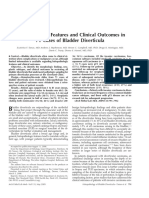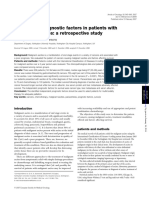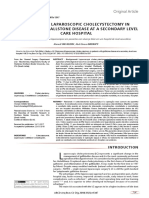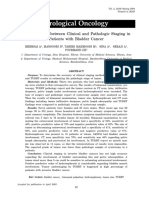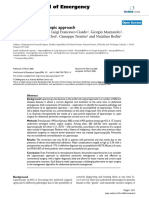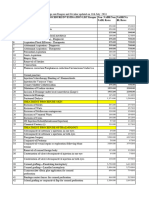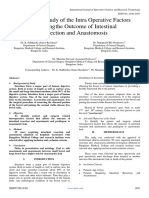Ca Sekum
Ca Sekum
Uploaded by
Nely M. RosyidiCopyright:
Available Formats
Ca Sekum
Ca Sekum
Uploaded by
Nely M. RosyidiOriginal Description:
Original Title
Copyright
Available Formats
Share this document
Did you find this document useful?
Is this content inappropriate?
Copyright:
Available Formats
Ca Sekum
Ca Sekum
Uploaded by
Nely M. RosyidiCopyright:
Available Formats
ORIGINAL ARTICLE
SURGICAL MANAGEMENT OF CARCINOMA CAECUM
Ainul Hadi, Zahid Aman, Shehzad Akbar Khan, Mazhar Khan, Zafar Iqbal
Department of Surgery,
Hayatabad Medical Complex Peshawar - Pakistan
ABSTRACT
Objective: To determine the magnitude of carcinoma caecum and its surgical management in the department of
Surgery, Hayatabad Medical Complex Peshawar- Pakistan.
Methodology: This case series study was conducted at surgical Unit Hayatabad Medical Complex Peshawar from
July 2006 to June 2009. A total of 32 patients of carcinoma of caecum were included that were admitted either
through OPD as elective cases (22 patients) or in emergency (10 patients). In elective cases, diagnosis was made on
colonoscopic biopsy while those who presented in emergency either with intestinal obstruction or with the suspicion
of acute appendicitis, were diagnosed on the resected specimen histopathology.
Results: Out of 32, 25 patients (78%) were male and 7 (22%) female, with a male to female ratio of 3.6:1. Their
mean age at the time of presentation was 65±2.8 years. Right hemicolectomy with side to side or end to end
ileotransverse anastomosis was performed in 23 cases (71.89%). In 3 cases (9.37%) ileotransverse bypass without
resection was carried out as the tumour was locally advanced. In 3 other cases (9.37%), only omental biopsy was
taken as the carcinoma was so advanced that any curative or palliative resection was not possible. In emergency
situation, right hemicolectomy with exteriorization of bowel ends was done in 3 cases (9.37%). Postoperative
morbidity included wound infection 12.50%, faecal fistula 9.37% and intraabdominal collection 6.25%.
Conclusion: Majority of the patients were having operable disease, however late presentation is very common.
Surgical intervention may prove to be a better option in such cases.
Keywords: Carcinoma of caecum, Large gut malignancy, Intestinal obstruction.
INTRODUCTION include lung and brain, however subcutaneous
metastasis is a very rare presentation but do occur 1 0 , 11 .
Carcinoma caecum/ascendi
Although right hemicolectomy for carcinoma caecum
ng colon
may be curative, but carcinoma involving this part of
accounts for up to 14% of colorectal tumours as r e p o
colon does not have a favourable prognosis and it is
r t e d f r o m t h e d e v e l o p e d c o u n t r i e s 1,2 .
believed to be due to diagnostic delay12,13.
Carcinoma of caecum is more common in western
countries but it is not a rare disease in our country 3. It
may present in variable ways e.g. occult bleeding per The aim of this study is to review data
rectum, gross bleeding through rectum, unexplained pertaining to caecal carcinoma such as age, sex,
anaemia, mass in right iliac fossa, acute appendicitis clinical presentation, diagnosis and treatment of
and even intestinal patients admitted to the department of surgery,
obstruction3 . Rarely it may present as mega i n t u s s u Hayatabad Medical Complex Peshawar over a period
cptionandrectalmass 4.Itusually of 3 years.
metastasizes to regional lymph nodes and later on
through blood stream5, 6. Haematogenous metastasis METHODOLOGY
usually occurs by embolization of cancer cells from This was a case series study and extended
primary tumour via mesenteric and portal veins to liver over a period of three years from July 2006 to June
which is the most common site of colorectal 2009. In this study patients of all ages and
metastasis7 - 9 . Other common sites
JPMI 2011 Vol. 25 No. 01 : 78 - 84 78
SURGICAL MANAGEMENT OF CARCINOMA CAECUM
both sexes with the diagnosis of carcinoma of caecum, in all elective cases to check the extent of spread of the
managed in the surgical department of HMC Peshawar disease. CEA was done in 22 cases (68.75%) who were
were included. Patients with past history of colonic admitted through OPD and was found raised. Patients
growth or recurrent growth were excluded from the presented in emergency either with intestinal
study. Similarly patients with e x t r a a b d o m i n a l obstruction or acute appendicitis, were routinely
m e t a s t a s e s l i k e c e r v i c a l lymphadenopathy resuscitated and then investigated, followed by surgical
and pulmonary metastases were also excluded. In intervention. Blood was arranged before surgery
elective cases diagnosis was made on colonoscopic according to haemoglobin status. Right hemicolectomy
biopsy while those presented in emergency either with with ileotransverse anastomosis was the preferred
intestinal obstruction or with the suspicion of acute procedure over ileostomy or bypass, in all resectable
appendicitis were diagnosed after receiving the cases.
histopathology report of the resected specimen.
In emergency situation, right hemico-lectomy
Data regarding the history clinical signs, with exteriorization of bowel ends was done in patients
investigations, surgical treatment and the outcome of with intestinal obstruction and haemodynamically
these patients were collected on a semi-structured unstable or with peritoneal contamination. Only
profroma . Preoperatively patients admitted through omental biopsy was taken in cas es w h er e th e g r o w
OPD were shifted to liquid diet to prepare the gut while th w as d is s emin ated extensively in peritoneal cavity.
those admitted with i n t e s t i n a l o b s t r u c t i o n , Patients were advised to come to OPD for
w e r e m a n a g e d o n intravenous fluids, nasogastric
follow up, initially monthly and then after every 3
suction and Foleys catheter to keep the intake and out
months.
put record and kleen enema to evacuate the distal
faecal bulk more commonly in elective cases. RESULTS
In this study a total number of 32 cases of
In elective patients, routine investigations like carcinoma caecum were collected. There were 25
full blood count, blood urea/creatnine, blood sugar, (78%) males and 7 (22%) females with a male to
blood grouping, ECG, X-ray chest and X-ray abdomen female ratio of 3.6:1. The age range was 30-80 years
(erect and decubitus films) were performed to look for with a maximum number having age between 61-70
the signs of obstruction. Specific investigations years. The mean age of patient at the time of
included stool examination for occult blood, abdominal presentation was 65 years ± 2.8 SD (Table 1).
U/S, barium enema (in 22 patients admitted as elective
cases) and colonoscopy with biopsy. Serum electrolytes Table 2 shows the different modes of
and LFTs were done where needed. CT scan was done presentation of patients. Out of 32 patients 22
Table 1: Age and gender of the sample (n =32)
Age range Male Female Total
30-39 years 02 00 02
40-49 years 03 01 04
50-59 years 04 01 05
60-69 years 14 04 18
70-79 years 02 00 02
80 years 00 01 01
Total 25 (78%) 07 (22%) 32 (100%)
Table 2: Modes of presentation (n =32)
Clinical features No of cases %age
Mass RIF 22 68.75
Intestinal obstruction 07 21.87
Acute appendicitis 03 9.38
Total 32 100%
JPMI 2011 Vol. 25 No. 01 : 78 - 84 79
SURGICAL MANAGEMENT OF CARCINOMA CAECUM
(68.75%) cases had clinical presentation of a mass in showed evidence of tumour in all cases. Biopsy
right iliac fossa, 7 patients (21.87%) presented with specimen was taken for histopathology during
intestinal obstruction while 3 patients (9.38%) had colonscopy.
signs and symptoms suggestive of acute appendicitis.
Table 4 shows the different operative
procedures performed. Right hemicolectomy with
Palpable mass in right iliac fossa or right primary ileotransverse anastomosis was performed in
lower abdomen was the predominant finding. Pain was 23 cases (71.89%), while in 3 patients (9.37%) who
the presenting symptom in 25 patients (78.13%) which presented in emergency with intestinal o b s t r u c t i o
was generalized in 17 patients n , r i g h t h e m i c o l o e c t o m y w i t h
(53.13%) and localized in right iliac fossa in 8 patients exteriorization of bowel ends was done. In 3 patients
(25%). Twenty two patients (68.75%) had significant (9.37%), the tumour was found to be advanced and
weight loss at the time of presentation, fixed, therefore only ileotransverse bypass procedure
15 patients (46.87%) had vomiting and 14 (43.75%) was undertaken. In remaining 3 cases (9.37%) tumour
were constipated. Four patients (9.37%) were pyrexic. was wide spread involving the peritoneal cavity and
liver rendering any surgical procedure impossible. So
Table 3 shows the abnormal pre operative an open omental biopsy was the only procedure which
investigations. Twenty eight (87.50%) patients had was undertaken and two out of these 3 patients expired
haemoglobin less then 10 gm. Blood urea was raised in postoperatively within 90 days of exploration.
08 (25%) patients. Stool for occult blood was positive
in 15 cases (46%). Plain X ray abdomen (erect posture)
Table 5 shows the morbidity of this study.
was carried out in all patients and revealed signs of
Four patients (12.50%) developed wound sepsis
intestinal obstruction in 7 patients (21.87%).
Abdominal ultrasound showed abnormal findings in 17 postoperatively, which was managed by opening up the
(53.13%) out of 32 cases. Barium enema Colonoscopy wound, draining the pus and regular wash of the wound
were performed in 22 (68.75%) elective cases and with saline and antiseptic solution and dressings. Two
patients (6.25%) developed faecal
Table 3: Pre Operative Investigations (n = 32)
Investigations No. of Percentage
Patients
Haemoglobin (less than 10 gm%) 28 87.50%
Blood Urea 08 25%
Stool for occult blood 15 46%
X ray Abdomen (erect posture ) 07 21.87%
Abdominal ultrasound 17 53.13%
CT scan (abdomen and pelvis) 21 65.63%
Barium enema 22 68.75%
Colonoscopy 22 68.75%
Table 4: Operative Procedures (n = 32)
Procedure No. of %age
Cases
Rt hemicolectomy with ileotransverse anastamosis 23 71.89%
Rt hemicolectomy with exteriorization of bowel ends 03 09.37%
Ileotransvers bypass without resection 03 09.37%
Omental biopsy only 03 09.37%
Total 32 100%
JPMI 2011 Vol. 25 No. 01 : 78 - 84 80
SURGICAL MANAGEMENT OF CARCINOMA CAECUM
Table 5: Post operative complications (n =32)
Complication No. of cases %age
Wound sepsis 04 12.50%
Faecal fistula 02 06.25%
Respiratory tract infection 02 06.25%
Jaundice 01 03.13%
Intra abdominal collection 02 06.25%
Wound dehiscence 01 03.13%
Septicemia 01 03.13%
Total 13 40.64%
Table 6: Histopathology (n = 32)
Histological features No.of cases Percentage
Adenocarcinoma 32 100%
?Well differentiated 23 71.87%
?Moderately differentiated 04 12.50%
?Poorly differentiated 05 15.63%
Lymph node status 25 78.13%
fistula due to anastomotic leakage which were reported but our present study show comparable results
reexplored and after peritoneal toilet, the two ends with studies from Pakistan as well as international
were exteriorized. Other complications included studies with some distinctive features3, 14, 15.
respiratory tract infection and intraabdominal
collection in 2 cases each (06.25%). Patients with Carcinoma of caecum is a disease of old age
intraabdominal collection were reexplored and but it can occur in young people also. Most of the
peritoneal wash was done. Postoperative jaundice, patients in our study were between the age of 61-70
wound dehiscence and septicemia occurred in one years, ranging from 30-80 years. These findings are
patient each (03.13%). Tension sutures were applied to comparable to different studies conducted by
burst abdomen. Total hospital stay depended upon the Gennero15, Sadozai AK14 and Amin MA3. This age
incidence is slightly earlier than maximum age
patient condition. Postoperative stay ranged from 7-25
incidence in developed countries. Maximum age
days. Hospital mortality was 03.13% (one case of
incidence over there is about 70-80 years 3. Similarly
septicemia which expired within 10 days post high incidence in old age in developed countries may
operatively, while 2 patients with advanced disease be due to increased average life of population3. Young
died within 3 months after exploration). people are not immune to caecal cancer. The youngest
patient in our study was 30 years male. A study
reported by Khawaja from Lahore, the average age was
Table 6 shows the histopathology report. All
45 years and the youngest patient was 17 years old16.
(100%) patients were reported having adenocarcinoma.
Caecal carcinoma is reported more commonly in
Out of 32, 23 (71.87%) patients had poorly
females than in males17 in a study which was explained
differentiated, 04 (12.50%) had moderately
by the fact that females suffer from billiary disease
differentiated and 05 (15.63%) had poorly
more than males and bile acids are thought to be
differentiated adenocarcinoma. In 25 (78.13%)
carcinogenic and responsible for this occurance. 3 But in
patients, the paracolic lymph nodes were reported to be
our study the male to female ratio was 3.6:1 which is
involved.
quiet opposite to the above study but is more consistent
with the study of Gennero 15 and 3:1 by Sadozai AK14
DISCUSSION
and Amin MA3 in their studies.
The true incidence and presentation of caecal
carcinoma from Pakistan is infrequently
JPMI 2011 Vol. 25 No. 01 : 78 - 84 81
SURGICAL MANAGEMENT OF CARCINOMA CAECUM
In the present study of 32 patients, 22 patients but both require bowel preparation and are sometimes
(68.75%) presented with abdominal mass as compared intolerable for the patients, abdominal ultrasound is
to 13% by Gemmero,15 45% by Zaki M,18, 50% by another excellent diagnostic modality with high
Sadozai AK14 and Amin MA3 each, indicating that it is sensitivity and moderate specificity in experienced
the most frequent mode of presentation. hands 2 5 . Ultrasound detects the p r i m a r y l e s i o
n , i t s s i z e , e x t e n t a n d e v e n secondaries in the
liver and so helps to stage the tumour 3. In our study
Though caecal tumours rarely produce abdominal ultrasound was performed in 22 patients and
obstructive symptoms due to its wide lumen and liquid picked up tumour with 100% accuracy.
contents, that leaves the carcinogenic component in diet
to remain in contact with the caecal wall for a short The management of colonic carcinoma
period19. However 7 patients (21.87%) in our study requires a combined approach by Surgeon, oncologist
presented with intestinal obstruction. This indicated the and Gastroenterologist but surgery remains the main
advanced stage of the tumour at the time of stay of treatment of carcinoma of caecum 14,26, since the
presentation. This figure is reported 20% each by only cure / palliation for carcinoma of the caecum is
Sadozai AK14 and Amin MA3. Only 3 patients (9.38%) enbloc resection. Therefore radical surgical excision is
were febrile and presented as acute appendicitis which the procedure of choice27. Right hemicolectomy with
is a rare presentation of carcinoma of caecum. This primary ileocolic anastomosis is a safe procedure in
figure is almost equal to 10% reported by Sadozai AK 14 good surgical hands and in patients having compara-
and Amin MA3. Twenty two patients (68.75%) tively good health. In the current study curative
presented with significant weight loss and 28 patients resection i.e. right hemicolectomy with ileotran-serse
(25%) had marked anaemia (Hb less than 10 gm %) anastomosis was performed in 23 cases (71.89%) while
showing the late presentation of patients as compared in emergency situation palliative or primary resection
to Western experience but almost similar to local and exteriorization of bowel ends was carried out in 3
studies3, 14. This may explain the late presentation of patients (9.37%) due to locally advanced tumour. Three
these patients with abdominal mass or bowel patients (9.37%) underwent palliative ileotran-sverse
obstruction. So any complication that develops in bypass surgery. In the remaining 3 patients (9.37%),
relation to early carcinoma can be a blessing for the only omental biopsy was possible due to metastasis in
patient as it draws the attention when curative resection the liver and peritoneal cavity. All these operative
is possible20. findings are comparable to local and international
Bariumenema,colonoscopyand studies3, 14, 15, 18.
abdominal ultrasound are important and reliable i n v e
stigationsforthedetectionofcaecal The operative mortality can be reduced by
carcinoma21. However spiral hydro CT scan 22 and proper selection of patients for various surgical
MRI23 are helpful in assessing the extramural extension procedures and it can even further be improved if
of tumour. In the present study, contrast radiology patients are operated upon by experienced surgeons.
barium studies were performed in 22 patients (68.75%) Histology showed 16 cases (50%) in Duke's B, 9(28%)
and the diagnostic yield was i00% in these patients. in Duke's C and 7 (22%) in Duke's D. No case was
Gennero reported positive results in 50 out of 54 reported in Duke Stage A. These figures are similar to
patients15 while Zaki M reported abnormal barium those reported in local studies3, 14. Hence 50% of our
studies in 74 out of 92 cases of caecal carcinoma 18. patients were in a d v a n c e d s t a g e D u k e ' s D a t
Sadozai AK14 and Amin MA3 reported positive results t h e t i m e o f presentation, showing that there is a
in 100% patients, confirming that double contrast trend for late presentation. Moreover histopathology
enemas may be more helpful in detecting early report s h o w e d t h a t 1 0 0 % o f t h e p a t i e n t s h
lesions14. Colonoscopy was also performed in 22 a d adenocarcinoma and the para colic lymph nodes
patients ( 6 8 . 7 5 % ) a d m i t t e d a s e l e c t i v e c a were involved in 78.13% (25) cases. These figures are
s e s a n d demonstrated tumour in all cases and also comparable to different studies3, 14, 15.
specimens were taken for histopathology. Sadozai
performed Colonoscopy in only 2 patients (5%) and I n t h i s s t u d y, 4 p a t i e n t s ( 1 2 . 5 0
reported tumour in both cases (100%) 1 4 . Where the % ) developed wound infection which was managed
endosocpic facilities are not available, contrast with opening the wound, draining pus, washing the
radiology (double contrast enema) remains the main wound and dressings. Two patients (6.25%) had faecal
stay of diagnosis in developing countries24. fistula due to anastomotic leakage and were reexplored.
Two patients (6.25%) had small intra abdominal
As barium enema and cononoscopy are the collections which were reexplored and peritoneal wash
gold standard for the diagnosis of colonic tumours was done, one patient (3.13%) had
JPMI 2011 Vol. 25 No. 01 : 78 - 84 82
SURGICAL MANAGEMENT OF CARCINOMA CAECUM
wound dehiscence, for which secondary tension sutures 8. Steel RJC. Disorders of the colonoid rectum. In:
were applied. These figures are comparable to local Cushieri A, Steele RJC, Moosa AR, editors.
studies carried out by Sadozai AK14 and Amin MA3. Essential Surgical Practice. 4th ed. London:
The hospital mortality was 03.13% (one case who had Butterworth International; 2002. p. 569-645.
developed septicemia due to anastomotic leak and died
within 10 days of surgery), which is comparatively less 9. Canaran C, Abrams KR, Mayberry J. Meta
than 10% reported by Sadozai AK 14 and Amin MA3 analysis: colorectal and small bowel cancer risk in
each and 19% by Gennero15. patients with crohns disease. Aliment Pharmacol
ther 2006;15:1097-1104.
At the time of discharge, patients were 10. Talpur AH, Kalyar SB. Carcinoma of caecum with
advised to visit OPD regularly for follow up. Initially subcutaneous metastasis. J Liaquat Uni Med
31 patients attended the OPD for check up but 02 Health Sci 2004;3:82-3.
patients died within 90 days after surgery and 06 were
lost during follow up. So their number reduced to 23 11. Jess T, Gamborg M, Matzen P, Munkholm P,
after 3 months. At 2 years follow up, 03 patients Sorensen TI. Increased risk of intestinal cancer
(11.54%) developed local recurrence and 05 patients in c r o h n s d i s e a s e : a m e t a a n a l y s i s o f
(19.23%) were picked up with distant metastasis, population bases cohort studies . Am J
mainly to liver. Fifteen patients (57.69%) were disease Gastroentrol 2005;100:2724-9.
free after 2 years follow up. Gennero had reported 12. Maqbool A, Iqbal M, Choudry AR. Carcinoma of
overall 5 years survival rate of 32.7% in carcinoma of caecum. J Surg Pak 1995;10:39-40.
caecum15.
13. Uza N, Nakase H, Kuwabara Y, Fujii S, Chiba T.
CONCLUSION Caecal cancer associated with longstanding crohns
disease. Lancet 2006;368:1842.
Majority of the patients were having operable
disease, however late presentation is very common. 14. Sadozai AK, Rauf MU, Tahir AA. Surgical
Surgical intervention may prove to be a better option as ma n a g e m e n t o f c a r c i n o m a o f c a e c u
enbloc resection i.e. right hemicolectomy with m . Proceeding Shaikh Zayed Postgrad Med Inst
ileotransverse anastomosis was done in majority of the 2000;14:19-22.
cases of our sample. 15. Gennero AR. Carcinoma of caecum. J Surg Pak
1995;10:39-40.
REFERENCES
16. Khawaja K, Ahmaed M, Durrani KM. Surgery for
1. Deleon ML, Schaetz D Jr. Colorectal cancer Lehey
colorectal cancer. Proceeding Shaikh Zayed
clinic experience 1972-1976. Dis Colon Rectum
Postgrad Med Inst 1990;4:4-7.
1987;30:237-42.
17. Goodman D, Irum TT. Delay in the diagnosis and
2. Mandal SK. Primary squamous cell carcinoma of
prognosis of carcinoma of right colon. Br J Surg
the caecum. J Can Res Ther 2009;5:328-30. 1993;80:1327-9.
3. Amin MA, Khan MA, Ayub M, Mahmood M, 18. Zaki M. Carcinoma of caecum . J Surg Pak
Ashraf M, Choudhry AR . Delay in the diagnosis 1976;8:36-9.
and prognosis of caecal carcinoma: a s t u d y o f 2
0 c a s e s . J Ay u b M e d C o l l Abbottabad 19. Brukstein AH. Update on anorectal cancer riks
2001;13:28-31. factors, diagnosis and treatment. J Postgrad Med
1989;86:83-5.
4. Rajput J, Memon S, Memon AH. Carcinoma of
caecum presenting as mega intussusception and 20. Eriguchi W, Matsunaga A, Futamata Y.
rectal mass. J Liaquat Uni Med Health Sci Appendicitis caused by caecal carcinoma: report of
2005;4:74-6. a case. Kurume Med J 2002;49:217-9.
5. Camei C, Turk HM, Buyukberber S. Colon
carcinoma with synchronous subcutaneous and 21. Schwartz SI, Shires GT, Spencer FC (eds). Colon,
osseous metastasis: a case report. J Dermatol rectum and anus. In: Principles of surgery. (6th
2002;29:362-5. ed). Philadelphia: McGraw-Hill; 1994. p.1259-78.
6. Bhat S, Pai M, Premnath RP. Primary squamous
cell carcinoma of caecum. Indian J Cancer 22. Cademartiri F, Luccichenti G, Rossi A. Spiral
2003;40:118-9. hydro CT in the evaluation of colo- sigmoidal
cancer. Radio Med 2002;104:295-306.
7. Charnley RM, Salem T. Colorectal liver
metastasis: indication for treatment. Surg Int 23. Shimizu J, Masutani S, Ishida H. A case of spinal
2003;62:156-60. infection related to hepatic arterial
JPMI 2011 Vol. 25 No. 01 : 78 - 84 83
SURGICAL MANAGEMENT OF CARCINOMA CAECUM
infusion chemotherapy. Gan to Kagaku Ryoho colonic cancer. Br J Surg 1998;85:530-3.
2003;30:1758-61.
26. Mehdi I. Gastrointestinal malignant tumours: are
24. Dunllop MG. Screening for large bowel neoplasms
they increasing? J Surg Pak. 1997;47:152.
in individuals with a family history of colorectal
cancer. Br J Surg 1992;79:488-94. 27. Armstrong CP, Ahsan Z, Hinnchley G, Prothero
DL, Brodribb AJM. Appendicectomy a n d c a r c i
25. Richardson NGB, Heriot AG, Kumar D. n o m a o f c a e c u m . B r J S u rg 1989;76:1049-
Abdominal ultrasonography in the diagnosis of 53.
Address for Correspondence:
Dr. Ainul Hadi
Department of Surgery,
Hayatabad Medical Complex Peshawar - Pakistan
JPMI 2011 Vol. 25 No. 01 : 78 - 84 84
You might also like
- Colorectal CancerDocument39 pagesColorectal CancerMuvenn Kannan100% (2)
- 4852-Article Text File-17070-1-10-20190208Document4 pages4852-Article Text File-17070-1-10-20190208Fillah Arzia ImaniNo ratings yet
- Periappendicular Inflammatory MassesDocument7 pagesPeriappendicular Inflammatory MassesA BNo ratings yet
- Acute Biliary Pancreatitis in Cholecystectomised PatientsDocument4 pagesAcute Biliary Pancreatitis in Cholecystectomised PatientsMayckolNigthClavijoDiazNo ratings yet
- Hippokratia 12 150Document3 pagesHippokratia 12 150hamdanNo ratings yet
- Bond 2003Document9 pagesBond 2003mgmgomaryamNo ratings yet
- Large Bowel Perforation: Morbidity and Mortality: K. Bielecki P. Kami M. KlukowskiDocument6 pagesLarge Bowel Perforation: Morbidity and Mortality: K. Bielecki P. Kami M. KlukowskiDiana AdămescuNo ratings yet
- Histopathologic Features and Clinical Outcomes in 71 Cases of Bladder DiverticulaDocument6 pagesHistopathologic Features and Clinical Outcomes in 71 Cases of Bladder DiverticulaIrma Suriani DarwisNo ratings yet
- Colorectal CancerDocument4 pagesColorectal CancerTinker Bell100% (1)
- A Cross-Sectional Study On Evaluation of Complete Blood Count-Associated Parameters For The Diagnosis of Acute AppendicitisDocument6 pagesA Cross-Sectional Study On Evaluation of Complete Blood Count-Associated Parameters For The Diagnosis of Acute AppendicitisJordan SugiartoNo ratings yet
- Original Article: A Study On Incidence, Clinical Profile, and Management of Obstructive JaundiceDocument7 pagesOriginal Article: A Study On Incidence, Clinical Profile, and Management of Obstructive Jaundicegustianto hutama pNo ratings yet
- WJG 8 267Document3 pagesWJG 8 267Marisela LimonNo ratings yet
- Comprehensive Surgical Staging For Endometrial Cancer: Management ReviewDocument7 pagesComprehensive Surgical Staging For Endometrial Cancer: Management ReviewAji PatriajatiNo ratings yet
- Ascites MalignantDocument5 pagesAscites MalignantAlizaPinkyNo ratings yet
- Kurum Boor 2016Document4 pagesKurum Boor 2016Chema ToledoNo ratings yet
- Medip, ISJ-4553 ODocument6 pagesMedip, ISJ-4553 OA BNo ratings yet
- Effects of Acupressure On Fatigue in Patients With CancerDocument1 pageEffects of Acupressure On Fatigue in Patients With Cancerqdnguyen.8390No ratings yet
- Celiac Lymph Node Resection and Porta Hepatis DiseaseDocument6 pagesCeliac Lymph Node Resection and Porta Hepatis DiseaseAndreeaPopescuNo ratings yet
- Incidental Gallbladder Cancer. Residual Cancer Discovered at Oncologic Extended Resection Determines Outcome. A Report From High - and Low-IncidencDocument10 pagesIncidental Gallbladder Cancer. Residual Cancer Discovered at Oncologic Extended Resection Determines Outcome. A Report From High - and Low-IncidencCarlos SotoNo ratings yet
- Per-Operative Conversion of Laparoscopic Cholecystectomy To Open Surgery: Prospective Study at JSS Teaching Hospital, Karnataka, IndiaDocument5 pagesPer-Operative Conversion of Laparoscopic Cholecystectomy To Open Surgery: Prospective Study at JSS Teaching Hospital, Karnataka, IndiaSupriya PonsinghNo ratings yet
- Bahasa IndonesiaDocument4 pagesBahasa IndonesiaNadiah Umniati SyarifahNo ratings yet
- Periampullary CarcinomaDocument35 pagesPeriampullary Carcinomaminnalesri100% (2)
- Gastro 1004Document4 pagesGastro 1004Paul HartingNo ratings yet
- Nipple Discharge 3Document3 pagesNipple Discharge 3Dima PathNo ratings yet
- CJC 33 02 087Document9 pagesCJC 33 02 087mantaaapujiwaNo ratings yet
- Klatskin Tumor 2Document8 pagesKlatskin Tumor 2Florian JeffNo ratings yet
- 1 s2.0 S2049080122014534 MainDocument5 pages1 s2.0 S2049080122014534 MainEleonore Marcelle Akissi Agni Ola SourouppPNo ratings yet
- Ca GástricoDocument8 pagesCa GástricoAndrea Rosales Cid De LeonNo ratings yet
- Abstracts / Pancreatology 19 (2019) S1 Es180 S30Document1 pageAbstracts / Pancreatology 19 (2019) S1 Es180 S30Hưng Nguyễn KiềuNo ratings yet
- Modern Management of Pyogenic Hepatic Abscess: A Case Series and Review of The LiteratureDocument8 pagesModern Management of Pyogenic Hepatic Abscess: A Case Series and Review of The LiteratureAstari Pratiwi NuhrintamaNo ratings yet
- Carcinoid Tumor of The Appendix: A Case ReportDocument3 pagesCarcinoid Tumor of The Appendix: A Case ReportrywalkNo ratings yet
- Small Intestine TumorsDocument8 pagesSmall Intestine TumorspkotaphcNo ratings yet
- Posterior Sagittal Anorectoplasty in Anorectal MalformationsDocument5 pagesPosterior Sagittal Anorectoplasty in Anorectal MalformationsmustikaarumNo ratings yet
- Clinical Outcomes of Laparoscopic Surgery For Transverse and Descending Colon Cancers in A Community SettingDocument6 pagesClinical Outcomes of Laparoscopic Surgery For Transverse and Descending Colon Cancers in A Community SettingpingusNo ratings yet
- A Rare Case of Colon Cancer in A Young Patient: A Case Report and Literature ReviewDocument5 pagesA Rare Case of Colon Cancer in A Young Patient: A Case Report and Literature ReviewIJAR JOURNALNo ratings yet
- Abses HatiDocument20 pagesAbses Hatisuherman paleleNo ratings yet
- Risk Factors and Surgical Management of Sigmoid VoDocument6 pagesRisk Factors and Surgical Management of Sigmoid VoJason OgalescoNo ratings yet
- Wjols 13 11Document5 pagesWjols 13 11Residentes CirugiaNo ratings yet
- Choledochal Cysts in Children: How To Diagnose and Operate OnDocument6 pagesCholedochal Cysts in Children: How To Diagnose and Operate OnRegita SiskaNo ratings yet
- Art 08 - Vol 5 - 2009 - NR 4Document7 pagesArt 08 - Vol 5 - 2009 - NR 4TezadeLicentaNo ratings yet
- Porcel (2012) Clinical Implications of Pleural Effusions in Ovarian CancerDocument8 pagesPorcel (2012) Clinical Implications of Pleural Effusions in Ovarian CancerLyka MahrNo ratings yet
- Complications of Laparoscopic Cholecystectomy: Tariq E. Al-Aubaidi MBCHB, FicmsDocument4 pagesComplications of Laparoscopic Cholecystectomy: Tariq E. Al-Aubaidi MBCHB, FicmsBurhan SabirNo ratings yet
- 2 PDFDocument7 pages2 PDFTaufik Gumilar WahyudinNo ratings yet
- Evaluation of Liver Space Occupying Lesion With Special Reference To Etiology and Co-Morbid ConditionDocument6 pagesEvaluation of Liver Space Occupying Lesion With Special Reference To Etiology and Co-Morbid ConditionRickySaptarshi SahaNo ratings yet
- Urological Oncology: A Comparison Between Clinical and Pathologic Staging in Patients With Bladder CancerDocument5 pagesUrological Oncology: A Comparison Between Clinical and Pathologic Staging in Patients With Bladder CancerAmin MasromNo ratings yet
- Evaluation complication laparo for hodgking deasesDocument3 pagesEvaluation complication laparo for hodgking deaseshounsourenstephNo ratings yet
- Primary Congenital Choledochal Cyst With Squamous Cell Carcinoma: A Case ReportDocument6 pagesPrimary Congenital Choledochal Cyst With Squamous Cell Carcinoma: A Case ReportRais KhairuddinNo ratings yet
- Open Versus Laparoscopic Cholecystectomy A ComparaDocument5 pagesOpen Versus Laparoscopic Cholecystectomy A ComparaChintya EltaNo ratings yet
- 1 s2.0 S0022480423002895 MainDocument7 pages1 s2.0 S0022480423002895 Mainlucabarbato23No ratings yet
- UreterostomiiDocument7 pagesUreterostomiivlad910No ratings yet
- NifasDocument6 pagesNifasjelly mutyaraNo ratings yet
- 5311JFP - OriginalResearch Fix FixDocument6 pages5311JFP - OriginalResearch Fix FixpratiwifatmasariNo ratings yet
- Primary Sarcoma of The Ovary Clinicopathological CDocument7 pagesPrimary Sarcoma of The Ovary Clinicopathological CfeisalmoulanaNo ratings yet
- Laparaskopi PeritonitisDocument5 pagesLaparaskopi PeritonitisPutri RiszaNo ratings yet
- Choledochal CystDocument5 pagesCholedochal CystZulia Ahmad BurhaniNo ratings yet
- Palliative Management of Malignant Rectosigmoidal Obstruction. Colostomy vs. Endoscopic Stenting. A Randomized Prospective TrialDocument4 pagesPalliative Management of Malignant Rectosigmoidal Obstruction. Colostomy vs. Endoscopic Stenting. A Randomized Prospective TrialMadokaDeigoNo ratings yet
- HPB 09 S2 071Document120 pagesHPB 09 S2 071Widya Dahlia JuwitaNo ratings yet
- Jnma 61 258 115Document4 pagesJnma 61 258 115Nicolás Mosso F.No ratings yet
- Abbas Et Al, Angka Kejadian PLADocument4 pagesAbbas Et Al, Angka Kejadian PLAhasan andrianNo ratings yet
- 1 s2.0 S0378603X14000503 MainDocument8 pages1 s2.0 S0378603X14000503 MainAdam DanuartaNo ratings yet
- Fast Facts: Cholangiocarcinoma: Diagnostic and Therapeutic Advances Are Improving OutcomesFrom EverandFast Facts: Cholangiocarcinoma: Diagnostic and Therapeutic Advances Are Improving OutcomesNo ratings yet
- Techniques of Bowel Resection and AnastomosisDocument7 pagesTechniques of Bowel Resection and Anastomosisfaris nagib100% (1)
- Could Laparoscopic Colon and Rectal Surgery Become The Standard of Care? A Review and Experience With 750 ProceduresDocument9 pagesCould Laparoscopic Colon and Rectal Surgery Become The Standard of Care? A Review and Experience With 750 ProcedurespingusNo ratings yet
- Chandigarh CGHS Rate List 2021Document46 pagesChandigarh CGHS Rate List 2021braroffriderNo ratings yet
- CPT PCM NHSNDocument307 pagesCPT PCM NHSNYrvon RafaNo ratings yet
- Ovunc Bardakcioglu (Eds.) - Advanced Techniques in Minimally Invasive and Robotic Colorectal Surgery-Springer US (2015)Document256 pagesOvunc Bardakcioglu (Eds.) - Advanced Techniques in Minimally Invasive and Robotic Colorectal Surgery-Springer US (2015)ravikanthNo ratings yet
- 2 Gunshot Wounds To The Colon Predictive Risk Factors For TheDocument5 pages2 Gunshot Wounds To The Colon Predictive Risk Factors For TheElizabeth Mautino CaceresNo ratings yet
- Sr. No. Non-NABH / Non - NABL Rates in Rupee Nabh / Nabl Rates in RupeeDocument45 pagesSr. No. Non-NABH / Non - NABL Rates in Rupee Nabh / Nabl Rates in RupeeEkanshNo ratings yet
- CGHS Rates - TrivandrumDocument79 pagesCGHS Rates - Trivandrumimran kureshiNo ratings yet
- Cghs Treatment Procedure/Investigation List (Bengaluru) : Sr. No. Non-NABH/Non - NABL Rates Nabh/Nabl RatesDocument49 pagesCghs Treatment Procedure/Investigation List (Bengaluru) : Sr. No. Non-NABH/Non - NABL Rates Nabh/Nabl Ratessurajss8585No ratings yet
- Ministry of Health & Family Welfare: Directorate General of CGHSDocument47 pagesMinistry of Health & Family Welfare: Directorate General of CGHSRahulTanejaNo ratings yet
- Simulasi Koding&Tarif Bedah Umum Rs Type D (Inacbg)Document1 pageSimulasi Koding&Tarif Bedah Umum Rs Type D (Inacbg)Achmad Dzulfikar AziziNo ratings yet
- CGHS Rates 2024 KanpurDocument43 pagesCGHS Rates 2024 Kanpurag0512tamNo ratings yet
- Kompetensi Bedah DigestifDocument5 pagesKompetensi Bedah DigestifOksayana Lutta100% (1)
- Renewed CGHS UpdatesDocument60 pagesRenewed CGHS UpdatesJanipalli HarishNo ratings yet
- Ayushman Bharat General Surgery List 4Document3 pagesAyushman Bharat General Surgery List 4Rahul SakalleNo ratings yet
- Surgical Endoscopy Journal 1Document86 pagesSurgical Endoscopy Journal 1Saibo BoldsaikhanNo ratings yet
- Gentamicin-Collagen Sponge For Infection Prophylaxis in Colorectal SurgeryDocument12 pagesGentamicin-Collagen Sponge For Infection Prophylaxis in Colorectal SurgeryNurul ImaniarNo ratings yet
- CGHS-Rates-2024 - Banglore AS ON JUL 24Document124 pagesCGHS-Rates-2024 - Banglore AS ON JUL 24compacctsdobktkNo ratings yet
- Sr. No. Cghs Treatment Procedure/Investigation List (Patna) UPDATED ON 03.05.2021Document41 pagesSr. No. Cghs Treatment Procedure/Investigation List (Patna) UPDATED ON 03.05.2021rupeshNo ratings yet
- 2017 JGO Value of Geriat ScreeningDocument8 pages2017 JGO Value of Geriat Screeningcheatingw995No ratings yet
- Colorectal SurgeryDocument73 pagesColorectal SurgeryShashidhara PuttarajNo ratings yet
- A Clinical Study of The Intra Operative Factors Affectingthe Outcome of Intestinal Resection and AnastomosisDocument6 pagesA Clinical Study of The Intra Operative Factors Affectingthe Outcome of Intestinal Resection and AnastomosisInternational Journal of Innovative Science and Research TechnologyNo ratings yet
- Colectomy Case StudyDocument6 pagesColectomy Case Studyvjfarrell0% (1)
- Perioperative Immunonutrition in Normo-Nourished Patients Undergoing Laparoscopic Colorectal ResectionDocument10 pagesPerioperative Immunonutrition in Normo-Nourished Patients Undergoing Laparoscopic Colorectal ResectionTeresa La parra AlbaladejoNo ratings yet
- ICD Bedah Anak REVISIDocument16 pagesICD Bedah Anak REVISIWaNda GrNo ratings yet
- R HemicolectomyDocument15 pagesR Hemicolectomyrwilah100% (1)
- s00464 013 2881 ZDocument200 pagess00464 013 2881 ZLuis Carlos Moncada TorresNo ratings yet
- Supplement Digital Content 1. Surgery Codes For A LaparotomyDocument6 pagesSupplement Digital Content 1. Surgery Codes For A LaparotomyMaja JeppesenNo ratings yet
- Ca SekumDocument7 pagesCa SekumNely M. RosyidiNo ratings yet







